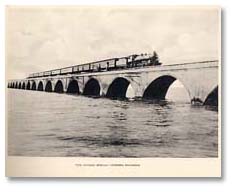 Florida East Coast
Railroad. The "Havana Special." Florida East Coast
Railroad. The "Havana Special."
The extension of rail service to Miami in 1896 transformed
the area from a sleepy tropical oasis into a thriving metropolis. All along
the route of his railway, Flagler built elegant hotels that would entice
tourists to travel on his railroad and then stay as guests at the resorts
located just steps from the station.
From the Ponce de Leon and the Alcazar
in St. Augustine to the Royal Poinciana in Palm Beach, Flagler’s hotels
developed a reputation for featuring some of the most luxurious amenities
travelers could expect. Writer Henry James once referred to the scene at the
Royal Poinciana as “Vanity Fair in full blast.” The same was true for the
Royal Palm Hotel, opened in Miami just one year after the railroad line was
completed there. Yet Flagler wanted a deep-water port as the terminus for
his railway.
Beginning in 1905, construction began on the Key West extension
of the Florida East Coast Railway, which would become known as the “railway
that went to sea.” The line was completed in 1912 and comprised seventeen
miles of bridges and twenty miles of embankments linking the Keys together
from Homestead to Key West. The “Havana Special” was a deluxe passenger car
that
took travelers all the way from New York to Key West in record time
(supposedly four hours, though most often longer) so they could then depart
on a ferry for Havana. The train ran until 1931, when the line went into
receivership. Following a devastating hurricane in Islamorada in 1935, much
of the trackbed was washed away. The remains of the railway were used to
construct the new Overseas Highway, completed in 1938.
|



